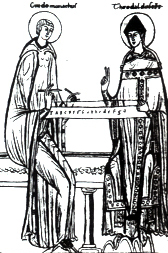
Tedald, Bishop of Arezzo
Encyclopedia

Tedald came from the highest ranks of the nobility of central Italy
Central Italy
Central Italy is one of the five official statistical regions of Italy used by the National Institute of Statistics , a first level NUTS region and a European Parliament constituency...
. He was the second son of Tedald
Tedald of Canossa
Tedald , of the House of Canossa, was the count of Brescia from 980, Modena, Ferrara, and Reggio from 981, and Mantua from 1006. He used the title of margrave because of his vast comital holdings and their frontier nature. His family's seat was Canossa and he was the son of Adalbert Azzo of...
, Count of Brescia
Brescia
Brescia is a city and comune in the region of Lombardy in northern Italy. It is situated at the foot of the Alps, between the Mella and the Naviglio, with a population of around 197,000. It is the second largest city in Lombardy, after the capital, Milan...
, of the House of Canossa, and Willa, possible daughter of Theobald II of Spoleto
Theobald II of Spoleto
Theobald II was the Duke of Spoleto and Margrave of Camerino from 953. He was the son of Boniface II of Spoleto and Waldrada. He married a woman also named Waldrada and was the father of Adalbert, Count of Bologna, and possibly of Willa, the wife of Tedald of Canossa.In 959, Berengar and Guy of...
. His elder brother was Boniface III of Tuscany
Boniface III of Tuscany
Boniface III , son of Tedald of Canossa and the father of Matilda of Canossa, was the most powerful north Italian prince of his age...
. He was the uncle of Matilda of Tuscany
Matilda of Tuscany
Matilda of Tuscany was an Italian noblewoman, the principal Italian supporter of Pope Gregory VII during the Investiture Controversy. She is one of the few medieval women to be remembered for her military accomplishments...
, who was born after his death.
As bishop Tedald encouraged and protected the monastic life
Monasticism
Monasticism is a religious way of life characterized by the practice of renouncing worldly pursuits to fully devote one's self to spiritual work...
. He granted permission for Saint Romuald to found a monastery and a hermitage (eremo) at Camaldoli
Camaldoli
Camaldoli is a frazione of the comune of Poppi, in Tuscany, Italy. It is mostly known as the ancestral seat of the Camaldolese monastic order, originated in the eponymous hermitage, which can still be visited....
in his diocese (c. 1024). Tedald also sponsored the work of the monk Guido of Arezzo
Guido of Arezzo
Guido of Arezzo or Guido Aretinus or Guido da Arezzo or Guido Monaco or Guido d'Arezzo was a music theorist of the Medieval era...
, whose treatise on music theory
Music theory
Music theory is the study of how music works. It examines the language and notation of music. It seeks to identify patterns and structures in composers' techniques across or within genres, styles, or historical periods...
, the Micrologus
Micrologus
The Micrologus is a treatise on Medieval music written by Guido of Arezzo, dating to approximately 1026. It was dedicated to Tedald, Bishop of Arezzo. This treatise outlines singing and teaching practice for Gregorian chant, and has considerable discussion of the composition of polyphonic...
, was dedicated to him. At Tedald's invitation, Guido took up the training of the cathedral singers at Arezzo around 1025. The bishop also supported the architect Maginardo
Maginardo
Maginardo , called Aretino, was an Italian architect active in the Diocese of Arezzo during the episcopates of Elempert , William , Adalbert , and Tedald , who called him arte architectonica optime erudito .Maginardo's career began in...
, who added to the cathedral
Cathedral
A cathedral is a Christian church that contains the seat of a bishop...
during his episcopate and was sent by Tedald in 1026 on a paid visit to Ravenna
Ravenna
Ravenna is the capital city of the Province of Ravenna in the Emilia-Romagna region of Italy and the second largest comune in Italy by land area, although, at , it is little more than half the size of the largest comune, Rome...
to study its Byzantine architecture
Byzantine architecture
Byzantine architecture is the architecture of the Byzantine Empire. The empire gradually emerged as a distinct artistic and cultural entity from what is today referred to as the Roman Empire after AD 330, when the Roman Emperor Constantine moved the capital of the Roman Empire east from Rome to...
.

